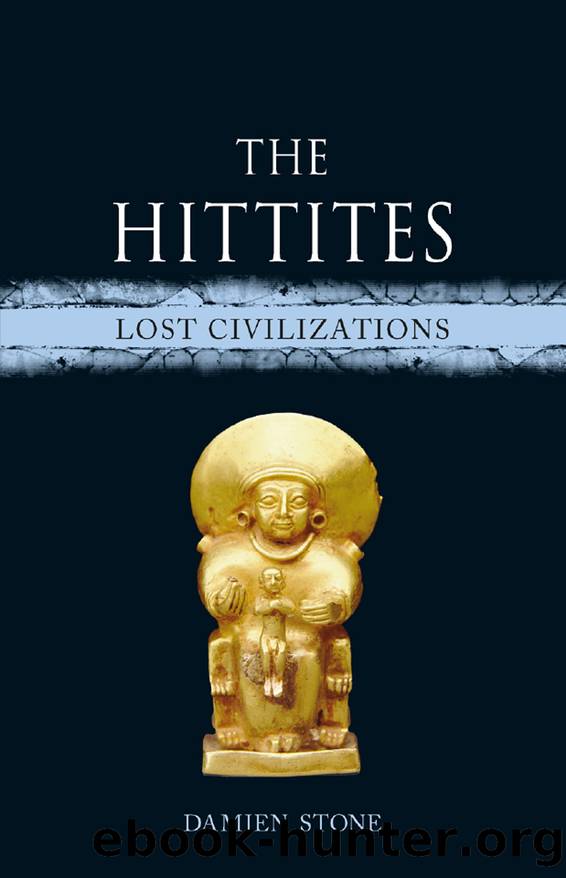The Hittites by Damien Stone

Author:Damien Stone
Language: eng
Format: epub
Publisher: Reaktion Books
One of the bronze standards found at the Pre-Hittite tombs at Alaca Höyük. They feature the enduring imagery of deer, bulls and sun-discs that continued to be popular into the period of the Hittite Empire. This example, featuring a triad of deer, was the inspiration for the modern Hittite Sun Course Monument of Sıhhiye Square in Ankara.
Karasu relief depicting a god standing atop a stag.
Hittite king and queen before the cult statue of a god in the form of a bull.
In Hittite art, animals appear as the companions of gods, but they were also used to define the nature of godsâ powers. Lions, for instance, frequently accompany representations of war deities. The depiction of a sacred animal by itself could also indicate the presence of their presiding deity.8 The KI.LAM festival included a parade featuring the animals of the gods, rendered in precious metal. Gold and silver stags, a silver panther, a silver wolf, a golden lion, a lapis lazuli boar, a silver boar and a silver bear were included in this procession. Again, it is in cultic text that we find these rich descriptions of aspects of Hittite material culture which have not survived.
The sacred animals are often portrayed as being stood upon by their corresponding deity. The prerogative bulls of the Storm-god may alternatively be depicted pulling his chariot. On a relief at Ä°mamkulu, his bull-drawn vehicle springs across the backs of three stooped mountain gods. Other animalâgod associations are found in the literary arts, rather than visual representation. Ḫannaḫanna was associated with the bee in Hittite literature. The insect, with its notions of abundance, is most appropriate for a mother goddess who presides over the home. In a myth where the god Telipinu goes missing, Ḫannaḫanna sends a bee out to find him. She instructs the bee: âWhen you find him, sting his hands and feet and make him stand up. Then take wax and wipe him off. Then purify him and make him holy again. Then conduct him back here to me.â9 In the Song of Hedammu, we find another rather charming example of animal imagery used to described Å auÅ¡ka (the Hurrio-Hittite name for Ishtar, the fertility and war goddess): âÅ auÅ¡ka anointed herself with fine perfumed oil. She adorned herself. And qualities that arouse love ran after her like puppies.â10
As with the gods, Hittite kings used animals to represent their royal prerogatives. Images of lions and eagles are closely associated with Hittite royalty. Recognizing their power, Hattusili I used both of these animals when describing the excellence of his person: âhis teeth are those of a lion, his eyes are those of an eagle, and he sees like an eagle.â11 In his testament which stipulated the rules for succession, Hattusili I similarly used the lion as a metaphor for kingship: âThe god will install only a lion in the place of the lion.â12 As we have seen, both Hattusa and Alaca Höyük featured lions and sphinxes (with their leonine features) as gateway guardians. These monumental stone
Download
This site does not store any files on its server. We only index and link to content provided by other sites. Please contact the content providers to delete copyright contents if any and email us, we'll remove relevant links or contents immediately.
| Anthropology | Archaeology |
| Philosophy | Politics & Government |
| Social Sciences | Sociology |
| Women's Studies |
Mysteries by Colin Wilson(2896)
People of the Earth: An Introduction to World Prehistory by Dr. Brian Fagan & Nadia Durrani(2355)
Ancient Worlds by Michael Scott(2115)
Foreign Devils on the Silk Road: The Search for the Lost Treasures of Central Asia by Peter Hopkirk(2064)
The Memory Code by Lynne Kelly(1964)
Lost Technologies of Ancient Egypt by Christopher Dunn(1806)
The Splendid and the Vile by Erik Larson(1795)
Come, Tell Me How You Live by Mallowan Agatha Christie(1774)
The Earth Chronicles Handbook by Zecharia Sitchin(1761)
The Plantagenets by Dan Jones(1624)
Last Chance to See by Douglas Adams(1607)
The Return of the Gods by Erich von Daniken(1580)
Wars of the Anunnaki by Chris H. Hardy(1397)
Before the Dawn by Nicholas Wade(1318)
Keeper of Genesis by Graham Hancock(1286)
The Cygnus Mystery by Andrew Collins(1265)
The Message of the Sphinx by Graham Hancock(1229)
Fragile Lives by Stephen Westaby(1119)
Hieroglyphs: A Very Short Introduction by Penelope Wilson(1039)
